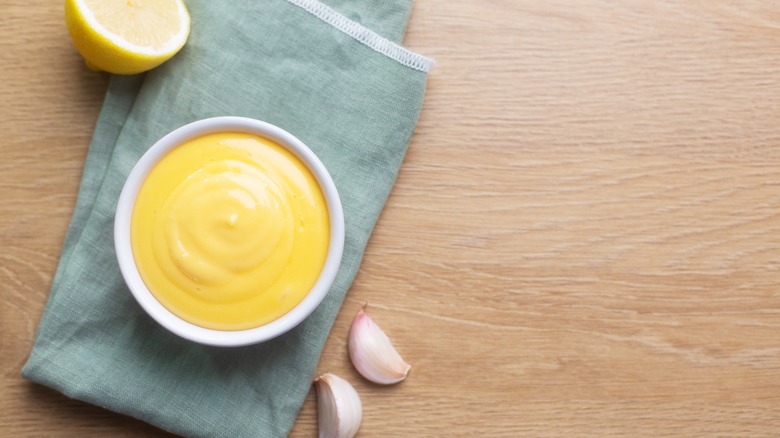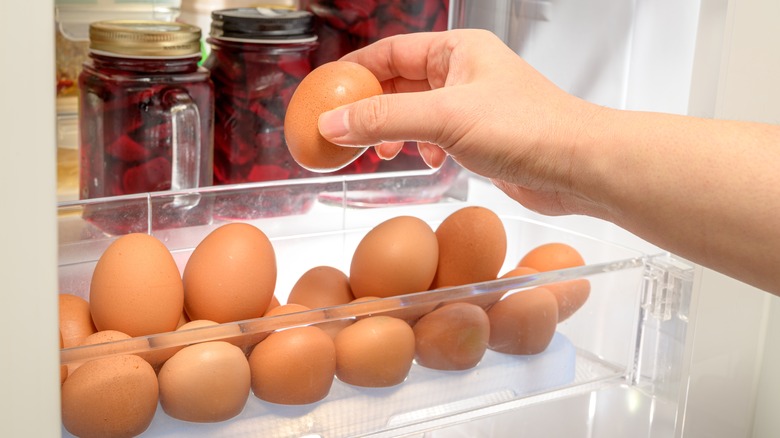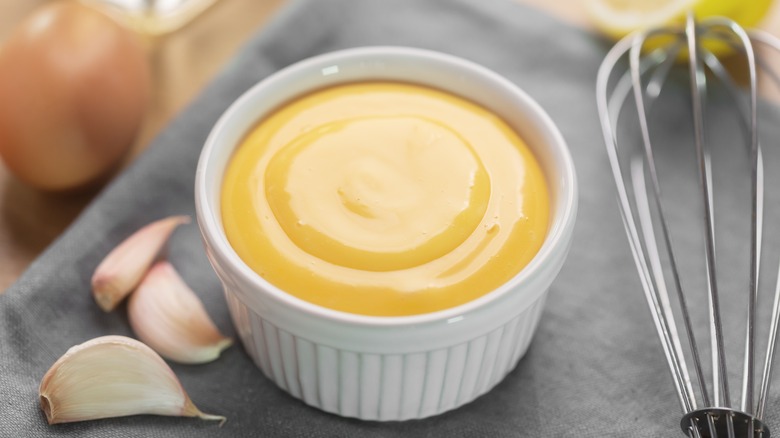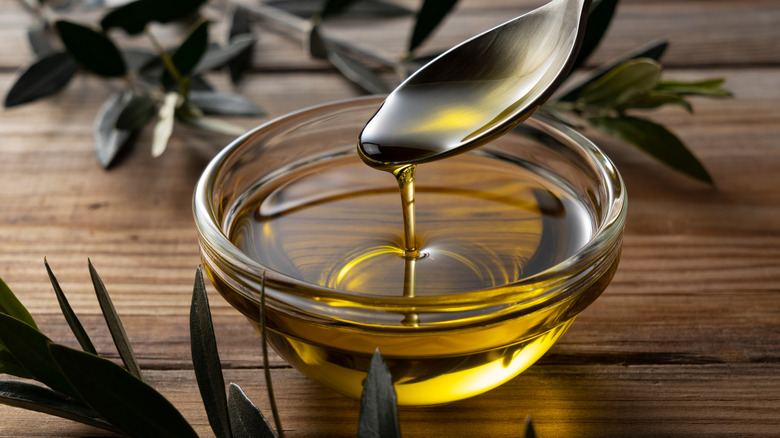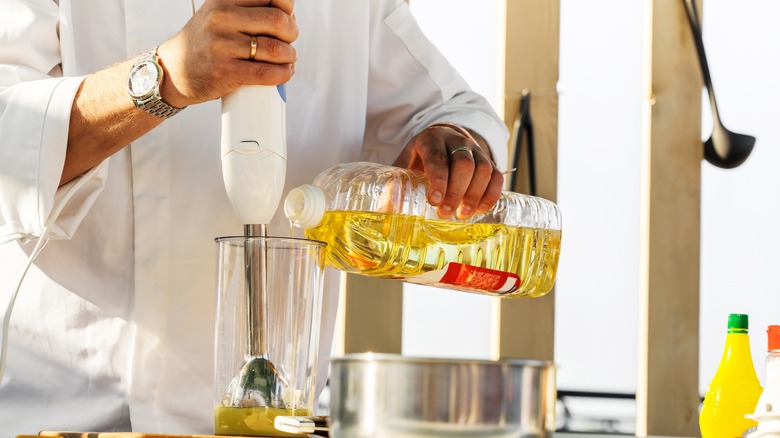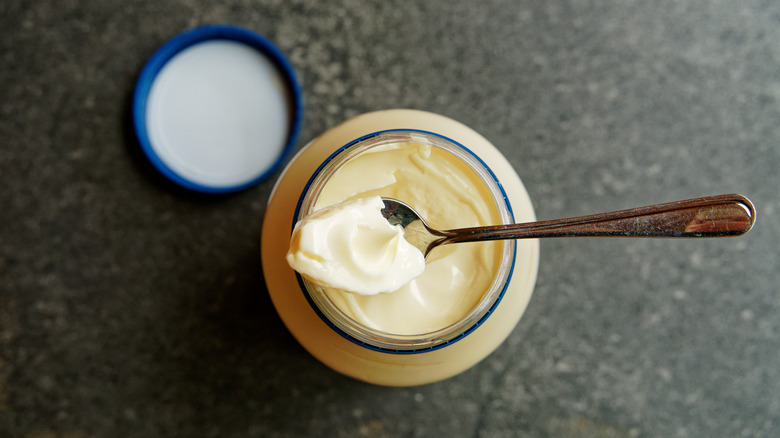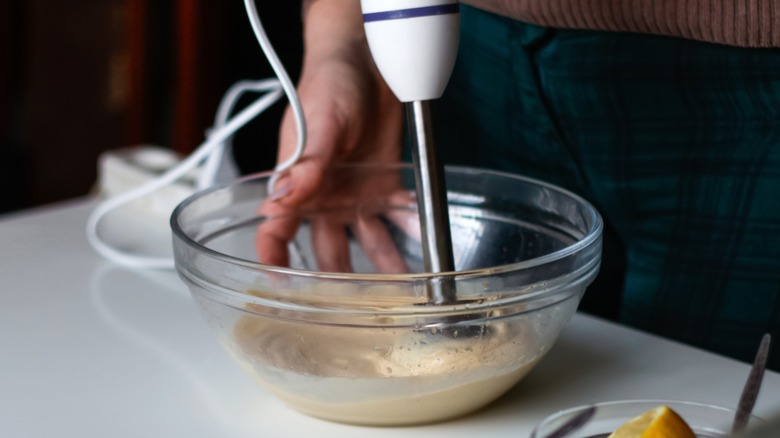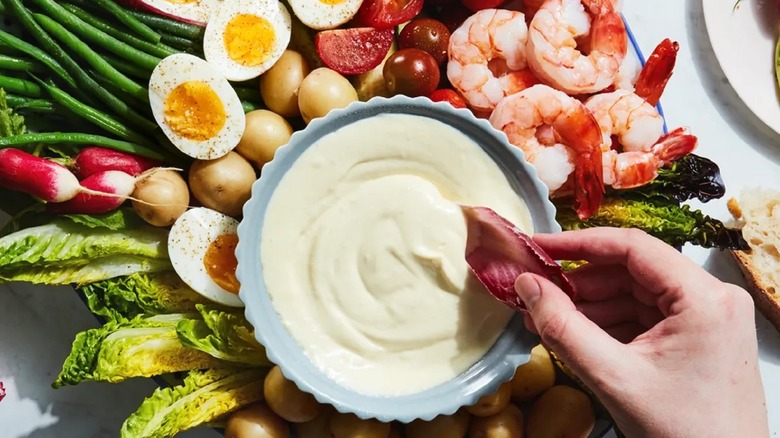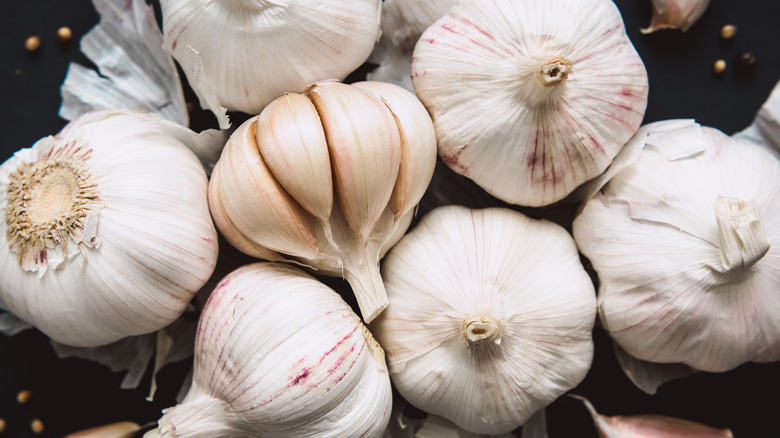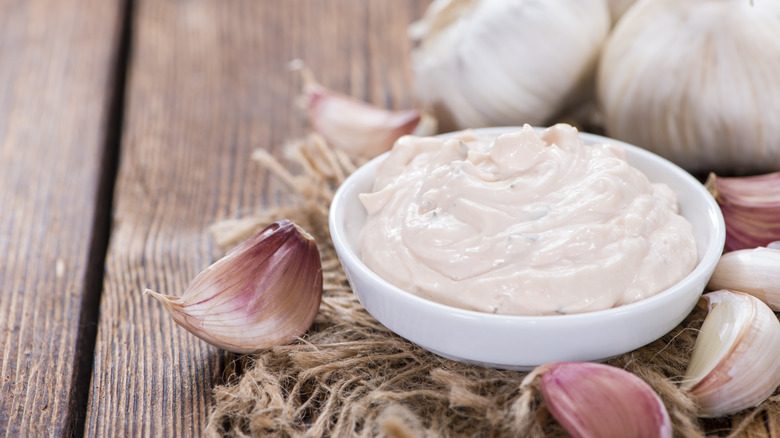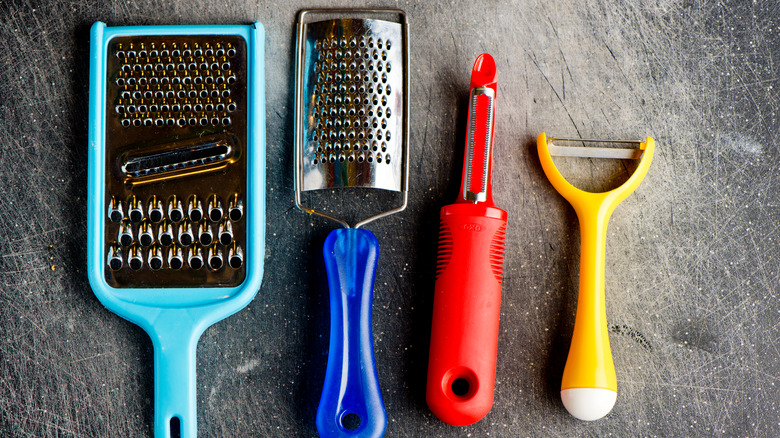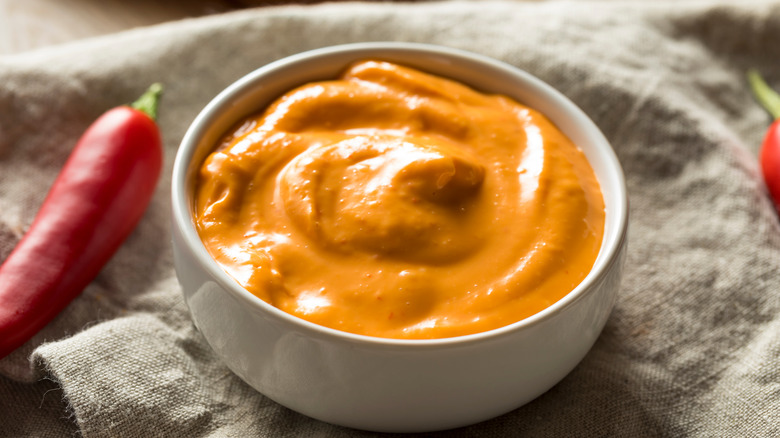13 Mistakes People Make With Homemade Aioli
Aioli is a popular and heavenly dip that is an excellent accompaniment to a lot of things. Although aioli has become a sort of byword for garlic mayonnaise, in its original form, it is a standalone sauce with a specific yet disputed regional history. Hailing from the Mediterranean, this sauce is simultaneously claimed to be both from Spain and France, with its name literally being a combination of garlic and olive oil. However, it is important to note that modern aioli sauces have evolved to include eggs, mustard, and other flavorings.
Aioli is commonly included in meals across several Mediterranean countries, and the combination of sharp garlic and creamy emulsified oil is hard to beat. But it is also hard to get it just right. While this dip is a simple combination of ingredients, it can go wrong fast. With our list of top mistakes, you are likely to serve up perfect aioli every time.
1. Using eggs straight out of the fridge
Egg yolks may be a common ingredient in your recipes, but if you are using them to make aioli, knowing how to handle them is crucial. And the first thing you need to get right is their temperature. Adding egg yolks to your aioli directly from the fridge increases the likelihood that the sauce won't come together as effectively. Egg yolks are high in lecithin, a fat that's commonly used as an emulsifier and to boost the texture of foods. It is this lecithin that works to bind together the ingredients in aioli, making it super creamy.
However, lecithin is far more effective as a binding agent when it is at a higher temperature. Using cold eggs, therefore, may prevent your aioli from coming together as smoothly. So, take your eggs out of the fridge around 30 minutes before you start making your aioli to let them come to the right temperature. If you forget to do this, you can speed up the process by pouring lukewarm water over them in a pot, then leaving them to stand for around 10 minutes. Make sure you give them the full length of time needed so that the warmth has a chance to get to the yolk in the middle.
2. The ratio of your ingredients is off
You can have the best ingredients in the world, but unless you are balancing them correctly, your dish is always going to taste off. And when making aioli, nailing your ratios is especially important. Adding too much garlic can overpower your sauce and take it from being fragrant and flavorful to acrid and bitter. Neglecting to add enough oil, on the other hand, will stop it from becoming creamy enough, with a sufficient amount needed for everything to emulsify effectively.
The same rule applies to egg-based aioli: Skimping on them will leave you with a sauce lacking texture and volume. The good thing about aioli is that if the proportions of your ingredients are wrong and you've added too much of one thing, all you have to do is boost the amount of the other stuff. And remember, if all else fails, you can simply try again. Just make sure you have enough backup ingredients on hand, so you can make another batch if things go seriously wrong.
3. Not using olive oil
Since aioli only requires a few ingredients, it is crucial you select the right ones. For your fat content, you need to make sure you use olive oil. While seasonings can be added for flavor, and newer aioli recipes include egg yolks, olive oil is the foundation upon which this classic sauce is built.
Using any other oil, therefore, simply won't cut it, as they may emulsify differently and will develop the dip into a different flavor. However, it is important to keep in mind that not all olive oils taste the same, either. If you have extra virgin olive oil, it may have a particularly robust, fruity taste, and this could impart flavor notes into your aioli that you'd rather not have. The best thing to do is a quick taste test of your olive oil to get a sense of whether it is too fragrant. But if in doubt, stick to regular olive oil.
4. Adding the oil too fast
In the kitchen, rushing through a recipe is hardly ever a good idea. Of all the foods you can ruin by speeding through things, aioli has to be up at the very top. One of the key mistakes that people make with aioli is throwing in their oil immediately. Simply put, if you add in your oil too quickly, you'll ruin the emulsifying process, which has to be taken super slowly. When this happens, the sauce will split, and all your hard work will be for nothing.
Let's say you rushed through this anyway, and your sauce does split, there might be a potential fix. Adding a teaspoon or two of hot water to a broken aioli may help bring the elements back together and re-emulsify the dip. Keep in mind, though, that this method may only be effective for aioli that's made with egg yolks in a more mayonnaise-like fashion.
5. Treating it like mayonnaise
With its eminently creamy consistency, and its ability to pair with a huge amount of foods, it might be tempting to mark aioli down as a flavored mayonnaise. But there are a few key differences between these condiments. Let's begin with the taste and ingredients. Mayonnaise generally has a slightly more subtle flavor and is created using canola oil. Conversely, aioli must include olive oil and garlic to give it a punchier taste. Although many aioli recipes include egg yolks, traditional aioli doesn't use them at all.
Another important difference is the way each is prepared. To make a classic aioli, you should use a mortar and pestle to pound the garlic into a paste and start the emulsification process with the oil. On the other hand, mayonnaise is usually made in a blender — it should be pointed out that these days, aioli can also be made in a blender depending on the ingredients used. Finally, another major difference is that aioli is generally considered a dipping sauce, whereas mayonnaise may be a little more versatile.
6. Blending it for too long
If you are making your aioli in a blender or with a blending tool, timing is everything. And as well as knowing when to add your oil, it is also important to know when to turn off your machine. Over-blending aioli can be a cardinal sin when it comes to making the dip, and doing so can cause the whole thing to split. This is because as your aioli whirs away in your machine, it can start to heat up slightly. This heat then breaks the condiment and ruins your hard work.
Therefore, make sure to quit while you are ahead. You should only blend your aioli until it is fully combined and creamy, and then leave it to rest. The same goes for if you are making it in a mortar and pestle — do not overwork the mixture. If your aioli does split, the best thing to do is likely to start again. Remember, though, that you can always put that split mixture to good use. Tip it into a bowl with some fresh green salad leaves, and toss it all together, to make a vibrant, springy salad.
7. Limiting what you serve it with
With traditional foods, it is easy to get a little puritanical about everything, and that extends to how we serve them. And while it is true that aioli is best served as a sauce, the number of things you can dip in it is pretty much endless. Aioli is most commonly found as a crudité dip, and it is undeniably a great accompaniment to freshly-cut carrots, celery sticks, radishes, and cucumber. If you want to take this to the next level, though, you can make a crudité-combo board with aioli at the center, known as the grand aioli. Combine sliced vegetables, hard-boiled eggs, and cooked prawns with a bowl of garlic dip for a showstopping snack plate.
And if you haven't tried aioli with fries yet, you might be missing out. Pile a bowl full of hot potatoes straight from your air fryer, and put a dish full of aioli next to them for the ultimate TV snack. Aioli also pairs well with chicken wings, tenders, and nuggets. And if you want a taste of garlicky goodness in every bite, spread your aioli onto your sandwiches instead of regular mayonnaise. The sky is truly the limit with this condiment.
8. Only using egg yolks
Aioli can be somewhat fiddly to make. Between knowing how to separate your egg yolks from the whites, making sure your measurements are correct, and stopping the sauce from splitting, it can be tough. So, some people try to keep their recipes sparse with ingredients and only stick to using egg yolks — another mistake. So, if you are not up to the task of making aioli entirely from scratch, you might want to try this shortcut: Add mayonnaise from a jar to your concoction.
To elevate this mixture even further, try adding some garlic, lemon juice, olive oil, and salt. Using store-bought mayonnaise as your base will help you easily create a delicious, fresh-tasting aioli. And your guests will have no idea that it mostly came from a jar — if you choose wisely. Keep in mind that your aioli will only be as good as the ingredients you use, so ensure that you get the best-quality mayonnaise you can find. The same goes for your other ingredients.
9. Not using fresh garlic over jarred
One of the main flavors in aioli is, of course, garlic. So, you will want to make sure that the garlic you use is of pretty good quality. One of the mistakes that many people make is using jarred garlic instead of fresh. When it comes to aioli, this can leave you with a bland, weird-tasting condiment.
The fact of the matter is that jarred garlic just doesn't have the same flavor as freshly-chopped or grated garlic. Garlic that is chopped fresh has a zingy, tasty flavor, but as it sits out and develops, it loses this, becoming dull and bitter-tasting due to oxidization. This oxidization also reduces the nutritional content of your garlic cloves, rendering them less good for you. Additionally, jarred garlic can be almost absurdly pricey when you consider how cheap fresh garlic bulbs are. Essentially, you are paying more for something to have less taste.
10. Forgetting to season it properly
If you are making aioli from scratch, please do not forget to use salt. This is, of course, one of the most important ingredients you can add to bring your dip together. The most important thing to do is add a little bit of salt at a time, mixing it in gently once your aioli comes together and tasting it as you go. Just be careful, as adding too much salt can render your dip inedible.
It can be useful to make a little more aioli than you'll think you'll need, as you'll lose some of it as you taste-test the dish. Remember that aioli also needs a good amount of lemon juice to truly be called an aioli dip. Lemon juice adds a vital astringency to the condiment and balances out the fat content in the dish with a zip of flavor. Again, taste as you go, and add more if necessary.
11. Not breaking your garlic down enough
One of the last things you want to happen when you are making aioli is for a massive chunk of garlic to work its way in. And yet, this is an all too common mistake that can end up ruining your dip. This usually happens when you are chopping your garlic by hand since it is harder to break it down with a knife. That's why, when you make aioli, you should be grating your garlic.
Using a grater to break down your garlic cloves will ensure that you do not end up with any big pieces of it in your dip. It will also give you the best distribution of flavor throughout your aioli. Grating garlic also gives you way more bang for your buck, as the more that the vegetable is broken down, the more it is able to release its flavor. If you do not have a grater, you can always use a garlic press to extract every last piece of garlicky goodness from the clove.
12. Keeping it in the fridge forever
Aioli is one of those foods that's great to make in larger quantities. Importantly, though, while some dips seem to last forever, aioli is not one of them. This goes for aioli that uses mayonnaise or egg yolks. Once you've made aioli, it shouldn't be kept in the fridge for longer than a week. You should discard the aioli if left out on the counter for more than an hour or two. Any longer, and it may become potentially unsafe to eat if you made it using mayonnaise or egg yolks.
Like most foods, aioli should be stored properly in an airtight jar or container. It is crucial to remember that, unlike some store-bought condiments, homemade aioli won't have any preservatives in it, and so the fresh ingredients used can turn pretty fast. If the dip starts to smell or look strange or begins to separate, you should throw it out and make a fresh batch. Aioli is also not suitable for freezing, so do not be tempted to extend its lifespan that way.
13. Not mixing it up
Even the most creative chefs can suddenly become pretty traditional when it comes to condiments. But why should we limit ourselves when it comes to aioli? Although the classic blend of garlic and oil is hard to beat, there's a world of aioli variations out there that will revolutionize your dip game. To add a little spice to your aioli, throw in some chipotle chiles or some Sriracha.
You might also want to consider chopping up some fresh thyme, oregano, and rosemary and adding them to your next batch. The floral notes these herbs provide will counterbalance the garlic's sharpness. You can bring out these fresh flavors even more by adding in a quick grate of lemon zest. Or, to give aioli a bit more earthiness, as well as a vibrant pop of color, add in a few strands of saffron. Whatever you desire from your dip, aioli serves as the perfect base.
